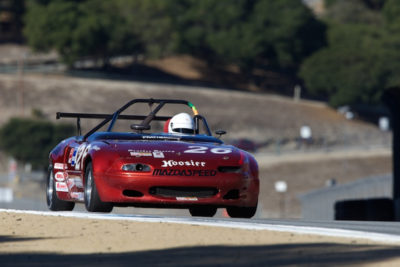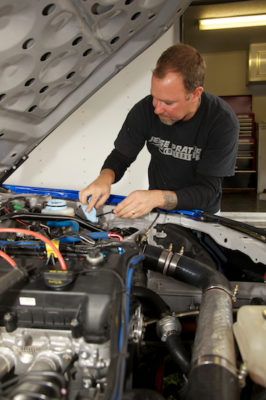Jesse Prather explains what a good set of double-adjustable shocks can do for a racer and help him or her tune the car.
Adjustable shock absorbers, or dampers if you prefer, are fairly commonplace at all levels of racing. Most are double adjustable for compression and rebound, some are adjustable for compression only, and the three-way shocks include high- and low-speed compression adjustments. They’re incredibly useful tools, if one knows what he or she is doing.
“Really good racing shocks are probably one of the biggest overlooked pieces on any racecar, because they’re hard to understand sometimes, and hard to figure out how to adjust properly,” says Jesse Prather, proprietor of Jesse Prather Motorsports and builder of championship-winning Miatas. “But it can make such a difference. The key to learning this kind of stuff is, A: testing; and B: getting some information from people that may know a little bit more than you do.”
Prather has a bit of experience working with adjustable shocks on the mostly Production-class Miatas he builds and in helping customers set up their cars correctly. He explains compression – sometimes called bump – as the shock’s ability to dampen the forces up against the spring. Compression is commonly used to adapt the car to track conditions, but it can also help make the car work better. He often calls rebound a secondary sway bar setting, he says, because it prevents the spring from stretching out.
Used in conjunction, these two settings can get you a long way toward having a car that works well, assuming your suspension geometry and spring rates are correct. But in order to use the shocks to cure a handling problem, you first have to identify where in a corner – braking and initial turn-in, mid-corner, or exit – the problem occurs, because the typical adjustment depends largely on that fact. “You would adjust the shocks differently depending on where in the corner it’s giving you trouble. That is really the key to figuring out how to adjust your shocks,” Prather says.

“There’s a black art to it,” he continues, before giving some examples of problems that might be fixed by a shock adjustment, with the disclaimer that the old, “If A, then B,” equation doesn’t work with all cars in all situations, and a little experimentation and testing will be in order.
“If you’ve got corner-entry oversteer, you’re in the middle of hard braking, you’ve got the car pitched in pretty tight…. I’ve seen corner-entry oversteer as not enough front compression; I’ve also seen it as too much rear rebound and the rear shocks are actually trying to pick the tires up off the ground.
“Corner -entry understeer is generally a situation of not enough front rebound. What happens is you turn the car in and the front of the car rolls over on itself, rather than having a nice, crisp turn-in. You need a good amount of front rebound to get the car to initially turn in; but a lot of times you’ll run into a situation where the car will turn in, but as you roll it down to the apex, the back end is starting to come around. That’s just an imbalance front to rear. A lot of that has to do with spring rate,” he adds.
The mention of spring rates is one more reminder that there are several factors in whether a car works correctly – geometry, spring rates, anti-sway bars and shocks, not to mention tires, camber, caster, toe and, what many people overlook when diagnosing handling problems, the driver. Problems at mid-corner could be several of those other things; problems at corner exit often boil down to driving technique, Prather says, although in a rear-wheel-drive car, consistent corner exit understeer can be helped by adding a chunk of rear compression.
Where many people start is getting the compression right for the bumpiness of the track. “You know you’ve got too much compression in the front of the car if the steering wheel is trying to jerk itself out of your hand as you go through the bumps. Instead of absorbing the bump, it’s bouncing over it,” Prather says. Err on the side of too soft on the compression, but dial in rebound carefully, he notes.
One might have started reading this hoping to end it knowing exactly how to adjust the shocks for just about every situation, but it’s not that simple. They key, though is to use the adjustment and learn how it affects your particular car.
“A lot of it is trial and error,” he says. “There’s nothing like some testing to figure out how to make something like that work. The number one thing is to twist on those knobs and figure out what it feels like. So many people put adjustable shocks in their car and never touch them. Why have adjustable shocks if you’re never going to adjust them?”


 ACCESSIBILITY
ACCESSIBILITY